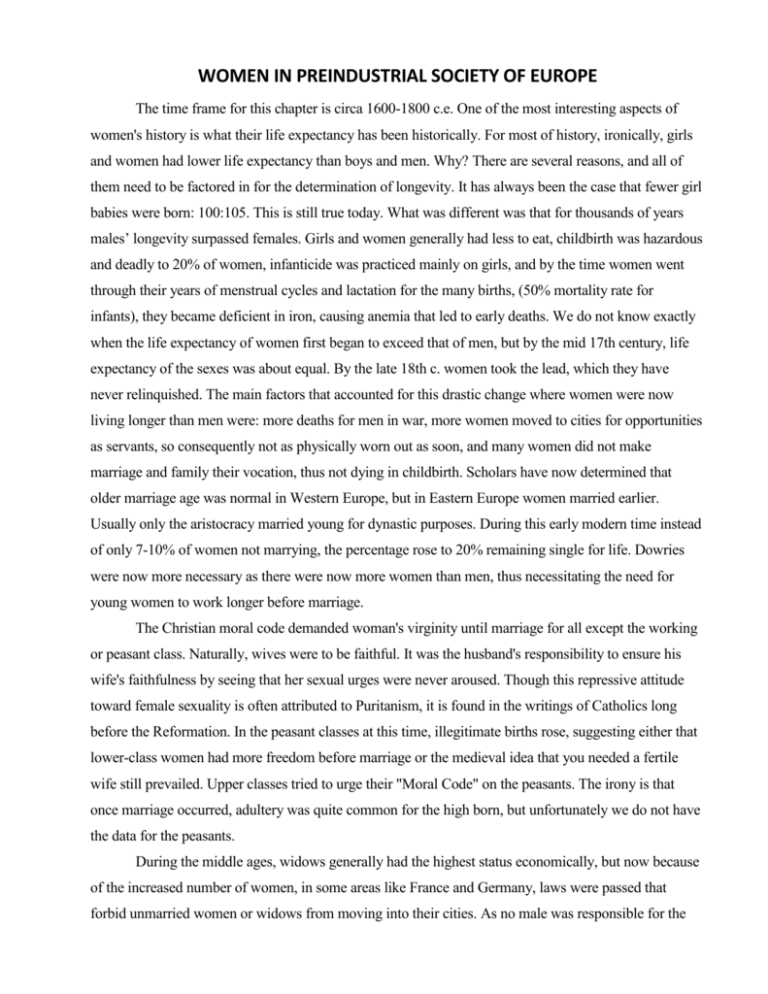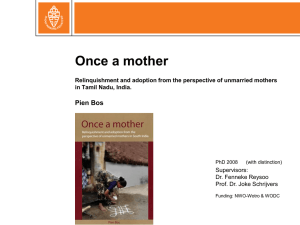Word 07
advertisement

WOMEN IN PREINDUSTRIAL SOCIETY OF EUROPE The time frame for this chapter is circa 1600-1800 c.e. One of the most interesting aspects of women's history is what their life expectancy has been historically. For most of history, ironically, girls and women had lower life expectancy than boys and men. Why? There are several reasons, and all of them need to be factored in for the determination of longevity. It has always been the case that fewer girl babies were born: 100:105. This is still true today. What was different was that for thousands of years males’ longevity surpassed females. Girls and women generally had less to eat, childbirth was hazardous and deadly to 20% of women, infanticide was practiced mainly on girls, and by the time women went through their years of menstrual cycles and lactation for the many births, (50% mortality rate for infants), they became deficient in iron, causing anemia that led to early deaths. We do not know exactly when the life expectancy of women first began to exceed that of men, but by the mid 17th century, life expectancy of the sexes was about equal. By the late 18th c. women took the lead, which they have never relinquished. The main factors that accounted for this drastic change where women were now living longer than men were: more deaths for men in war, more women moved to cities for opportunities as servants, so consequently not as physically worn out as soon, and many women did not make marriage and family their vocation, thus not dying in childbirth. Scholars have now determined that older marriage age was normal in Western Europe, but in Eastern Europe women married earlier. Usually only the aristocracy married young for dynastic purposes. During this early modern time instead of only 7-10% of women not marrying, the percentage rose to 20% remaining single for life. Dowries were now more necessary as there were now more women than men, thus necessitating the need for young women to work longer before marriage. The Christian moral code demanded woman's virginity until marriage for all except the working or peasant class. Naturally, wives were to be faithful. It was the husband's responsibility to ensure his wife's faithfulness by seeing that her sexual urges were never aroused. Though this repressive attitude toward female sexuality is often attributed to Puritanism, it is found in the writings of Catholics long before the Reformation. In the peasant classes at this time, illegitimate births rose, suggesting either that lower-class women had more freedom before marriage or the medieval idea that you needed a fertile wife still prevailed. Upper classes tried to urge their "Moral Code" on the peasants. The irony is that once marriage occurred, adultery was quite common for the high born, but unfortunately we do not have the data for the peasants. During the middle ages, widows generally had the highest status economically, but now because of the increased number of women, in some areas like France and Germany, laws were passed that forbid unmarried women or widows from moving into their cities. As no male was responsible for the 2 female, it was perceived that widows and unmarried women had more independence, not a characteristic suitable for patriarchal structures. Another even more significant development in the history of women was a more systematic control of human fertility. In parishes studied in England and France in the 16-17th centuries, people tended to have children very quickly after marriage. Often the bride was already pregnant as the wedding took place. Between one-fourth to one-third of the brides went to the altar pregnant. By the late 17th century in some places studied, after the birth of the third or fourth child, births became less frequent. This appears to be a deliberate choice and not just the result of approaching menopause. What method did women use to limit their number of children? Research is still on-going, but we have the following evidence: Herbal brews were still available to prevent pregnancies. The English author Chaucer and other later sources mention the use of sponges, and other devices to prevent pregnancy. With the presence of the printing press, by the 16th and later centuries, perhaps the knowledge was distributed more readily. We know that literacy for girls and women increased during this time. While there were increased references to Onanism, Puritans and other staunch Christians ranted against coitus interruptus or the Act of Onan, and masturbation to prevent conception. Several new methods were invented during this preindustrial period. We see the bidet being used in France by the 18th century, but contrary to what we might think it was mainly used to avoid venereal disease not avoidance of conception. Also by the 18th century condoms made of animal bladders or fine lamb skins were being utilized, and probably for the same reason as the bidets. Probably coitus interruptus was the most well known method, but nursing patterns, infanticide and abortion were also contraceptive methods used throughout history and undoubtedly still being utilized during this period of history. Historians are now thinking that variations in attitudes toward breast feeing influenced the use of contraceptives too. We know that mothers used extended breast feeding to space births and protect the health of their babies. Despite the definite benefits, breast feeding has always waxed and waned in popularity. Studies of this in Italy are the most numerous. Elite children were sent out to wet nurses, and girls were left with wet nurses longer than boys. The Catholic Church had ambivalent ideas on this. On the one hand they stressed duties of motherhood, and at least in the 16th century, the French declared that women who refused to nurse were worse than beasts. On the other hand the Catholic Church long argued that the husband's demand for resumption of sex after birth of a child was preeminent, and that it had to be allowed even if it resulted in the interruption of maternal nursing and endangered the life of the newborn. English aristocratic mothers often sent their first children to wet nurses, but later births they nursed their babies themselves, in what appears to be a concerted contraceptive measure. In the 18th century doctors and philanthropists led campaigns in favor of women nursing all their children. There 3 was now awareness that the mother's first milk or colostrum was so beneficial to her baby. By contrasting nursing practices of the French and English, it helps explain the French's recourse to the use of contraceptives more so than the English. Women in England breast fed their children more than French mothers and other continental countries. Thus the infant mortality rate was lower in England, and births more widely separated (i.e. 20 months apart). Until the late 17th c. French notables sent out their children to wet nurses, consequently children were closer together. Most all studies have shown a high infant mortality rate for wet-nursed infants. In Rouen, France, 18.7% of infants nursed by their mothers died, but twice that rate occurred for those babies sent to wet nurses. Abortion has been used as a contraceptive device throughout history all over the world. In this preindustrial period we find women used a variety of ways to abort. As the clothing styles had changed from loose garments, tying the waist tightly sometimes worked. Carrying too heavy of objects and herbal concoctions were the other methods used. There is much recent debate about whether any of these abortifacients effective. We now know that some did contain substances that strengthened uterine contractions like ergot, rue, and queen anne’s lace. With the decline of midwives and herbalists, proper dosages were lacking, and these plants can be deadly in large doses. For many unmarried women, pregnancy meant disaster. They would be out of work, necessitating hiding their pregnancies and birth of the child. Many then gave birth in outhouses, cow stalls, hay mounds or dung heaps, hoping to avoid public notice. Foundling hospitals or homes started opening up all over Europe and the numbers of babies dropped off at these places increased dramatically. When all else failed, then infanticide occurred. Before the 16th century, church and secular courts heard very few cases of infanticide as jurists recognized physicians could not make the infallible distinction between stillbirth and infanticide. This leniency changed in the 16th century when infanticide became legally equated with murder in most areas. The death penalty was often by drowning. A French royal edict of 1556 required that all unmarried women were to make an official declaration of their pregnancy. This decreed the death penalty for any woman whose infant died before baptism. Similar statutes passed in England (1624) and Scotland (1690), and apparently these stringent statutes were rigorously enforced. In some areas the percentage of those women accused of infanticide and executed was much higher than the percentage dying after accusations of witchcraft. For example, in Geneva 25 women out of 31 charged with infanticide were executed as compared with 19 out of 122 charged with witchcraft. In England the conviction rate for infanticide decreased after 1680 when women successfully argued that they had not intended to kill their child and had prepared linen for the baby or killed the child accidentally or through ignorance. Women were still executed for presumed infanticide in Scotland until 1776. Midwives in some places were enlisted to help enforce the statutes. Where a foundling or 4 abandoned child was found, the midwife might be asked to examine the breasts of all unmarried women in the parish. By the late 17th and early 18th centuries new interest in preserving the lives of abandoned children occurred. Wealthy patrons saw this as a worthwhile endeavor. Large foundling hospitals were established in all major nations. Probably the two most famous were the Paris Foundling Hospital 1670, and the London Foundling Hospital established in 1739. Russia had ones in both Moscow and St. Petersburg. The London Hospital had by the mid 18th century far too many children being brought to it and not enough funds. Thus, the lottery system was established, using colored balls. In St. Petersburg 25,000 abandoned children per year were funneled through these foundling homes. Consequently, a tremendous increase in the number of deaths of infants resulted, which meant that until the mid 18th century, families had just enough children to sustain the population, not increase it. In France in the 18th century, Napoleon invented the turn table to protect the identity of the mothers, and the French nobles turned to contraception using the bidet and condom. This is a natural outcome, showing where France had higher infant mortality rates than England, so consequently they employed more creative contraceptive devices. Then too, England went into the industrialization process earlier than the rest of the nations of Europe, so the demand for child labor rose, and so less contraceptives were used. There were also other options for pregnant unmarried women. As the numbers of this category increased, sometimes the courts ordered a marriage to take place. If his daughter was a minor, a girl's father could go to court and sue the man involved for "trespass and damages" to his property. Also a young woman could go herself to a local court in an attempt to prove the promise of marriage was made in order to coerce the man to marry her. Marriage was always the favored official solution, and surprisingly a number of cases accepted the courts' marriage plan, perhaps indicating an informal agreement was previously made. In cases where marriage was impossible, i.e. the man was married already, then the courts might order the man to maintain the child for a set period of years. This apparently worked best in Scotland where 65% of men accused of fathering illegitimate children admitted to it, and paid over half of their annual wages for several years to support the child. Some of the other pregnant unmarried women might charge the man with rape as it was now a capital crime in many parts of Europe, but the actual sentencing was still light for just monetary fines and brief imprisonments were meted out. The severity of the sentence was dependent on the social status of the victim and perpetrator. The victim had to prove she had cried out to repel the attacker, a policy that goes back to the ancient Mesopotamia area nearly 5000 years ago. Attempts were made that conception proved consent, but the courts did not always accept this. Some judges forced the rapist to marry the woman as a way for her to gain back her reputation. This occurred in Medieval Spain too. 5 Another option for unmarried pregnant women was to go live with friends or relatives until the birth of the baby. In many parts of Europe it was illegal to harbor unmarried pregnant women, but typically the consequences of unwed motherhood varied throughout Europe. Rural areas suffering labor shortages were the most tolerant of unmarried pregnant women. In Scotland unmarried mothers could do public penance, and then were considered purged of their sin, and able to gain employment and keep her child. In rural Norway a quarter of the unwed mothers married men other than the father of the child, one to six years after giving birth. England had the strongest stigma for unwed mothers. One scholar, Peter Laslett, has discovered that certain families were particularly prone to practice unwed parenthood. Some women gave birth to two to three children out of wedlock. Women in the Economy Peasant women have always contributed economically to the household by a variety of ways, but by this time a woman's main value and worth was predicated on her ability to establish and maintain the household. So much of a woman's life was initially devoted to aiding her parents in their livelihood, and then assisting her husband in his work. However, the kind of work girls and married women did differed markedly between the rural and urban areas. As three-fourths of the population lived in the countryside, the majority of men and women worked in agriculture, continuing the life style of thousands of years. By the age of seven a young girl was expected to make contributions to the household. If she lived on a farm she took care of the chickens, watered the animals, and carried food to adult workers. In the cities, if in an artisan’s household, it meant the young girl cleaned, carried wood and water, and then learned how to make thread on the spinning wheel, plus weaving and sewing. The young girl would remain in her parents home as long as she made a real contribution to the family enterprise, or as long as her labor was not more valuable and remunerative elsewhere. The farm girls would then leave home usually between the ages of twelve and fourteen. They might go to another farm or more likely migrate to nearby towns. There they would go into retail sales of food and clothing or become a servant, a logical extension of the work they did at home. As a domestic servant they cooked, cleaned, did childcare, took care of ill people and cared for the elderly. Domestic service was the largest single employer of women. In most of the cities, domestic servants made up 15-20% of the population. These young women would work at least ten to twenty years to acquire the necessary capital for a dowry as marriage was an economic partnership. Domestic service was a lifelong occupation for many women as they never married. Married women on the farms did a variety of duties: assisting their husband in planting, weeding, harvesting crops, and clearing the land. It was also the wife's responsibility to take care of various dairy products as a side industry, weaving and producing clothing, and maintaining the garden and orchards. Most farms by now were not an adequate size to make a living, forcing the husband to do work on other 6 farms, fishing or migrant labor. Actually, a wife could be in charge of the farm, and doing the hard work of ploughing, planting and harvesting. In the city a wife of an artisan or merchant often acted in the capacity as the business manager. An adequate food supply for the family was always the dominant concern of women or wives. Domestic duties, childbearing, and child rearing were subordinate to the necessity of eating. If economic disaster struck the family, more often than not it was the wife who organized what one historian has called "the Economy of Expedients", where the family members might be sent off to find work elsewhere or even beg in the streets. Women of the poorer classes did the same manual labor as men: street sweeping, hauling wood or building supplies, and mining. With the development of capitalism and wages, women's domestic labor was considered not wage work, so unpaid. And remember to keep in mind that people thought that women's work was temporary, as it was presumed that these women were just working long enough to earn money for a dowry to solve their economic problems. Women were not allowed into professions that required long training, such as apprenticeships. This decline of women's status and pay became more noticeable as the early modern period progressed. In 1500 women had been an essential part of household workshops. Their status was recognized by their community. By 1650 wives and widows could no longer have an active role in production. Women who worked in similar jobs to men received lower ages. They had no supervisory authority. Their wages were often so low that they had to work twelve to sixteen hours per day to support themselves. Economic need for cheap labor kept women's wages low.








